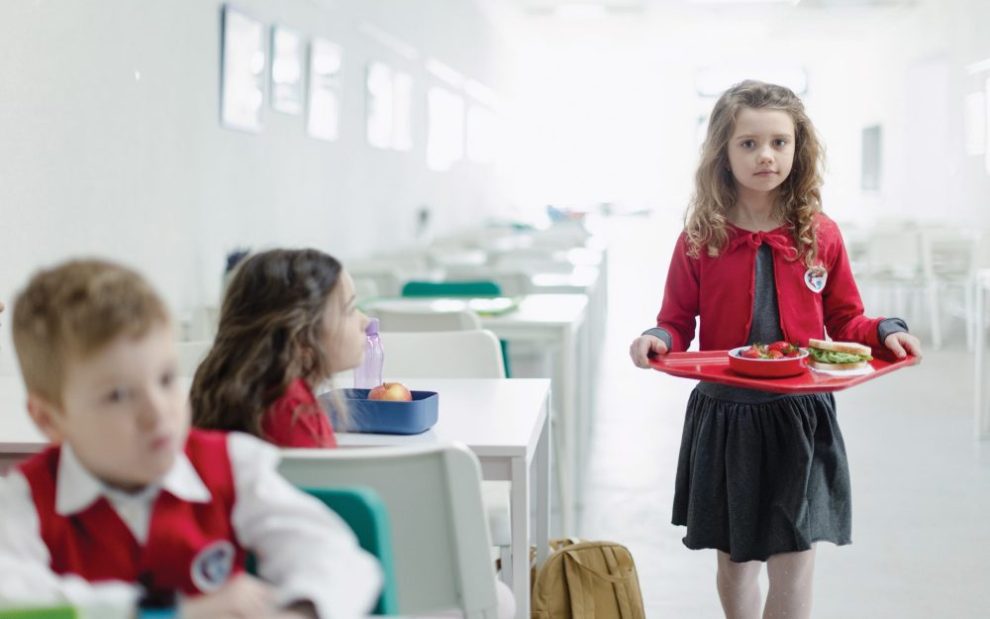Since first grade, my daughter’s best friend has been a boy. They share what Dr. Seuss called “compatible weirdness”—cracking each other up with drawings or spinning stories for hours. At school, their moments to connect came in the gaps between lessons and, most importantly, at lunch.
So she was shocked when a new principal separated boys and girls in the cafeteria, cutting off their daily time together. Already feeling out of sync with her female classmates, she was outraged. Having learned the term “gender segregated” firsthand, she launched a petition to restore the old seating. Every kid in her class signed, and their supportive teacher promised to bring it to the principal.
The teacher returned a different woman. The discussion was closed, she informed the class. God knows the reception this poor young woman had received from the principal.
Licking her activist wounds, my daughter turned up in my home office after school one day and asked why a gender-segregated cafeteria was so important that her principal would be that inflexible about it.
The question stopped me. All I had to go on were context clues, little flourishes that had emerged elsewhere from this new school administrator, as well as in our local church in general.
If I had to put a name to it, I’d call it a slide toward the pious. We make hundreds of little choices every day, and through the lens of our parochial school, I could see that the Catholic culture of my Midwestern home had been making plenty over the past decade—such as encouraging even the youngest grade schoolers to participate in eucharistic adoration; turning to the appropriate stained-glass window to recite the St. Michael Prayer after every school Mass; introducing a curriculum centered on virtues. None of these are bad things in themselves! (Though I do wonder if the militaristic, spiritual-warfare, us-versus-them framing of the St. Michael Prayer is the healthiest thing for an 8-year-old to internalize.)
At school, their moments to connect came in the gaps between lessons and, most importantly, at lunch. So she was shocked when a new principal separated boys and girls in the cafeteria, cutting off their daily time together.
Already feeling out of sync with her female classmates, she was outraged. Having learned the term “gender segregated” firsthand, she launched a petition to restore the old seating. Every kid in her class signed, and their supportive teacher promised to bring it to the principal.
The teacher returned a different woman. The discussion was closed, she informed the class.
So I took a breath and decided to tell it to my daughter as straight and accessibly as I could:
“Well, there are a lot of religious people in our country today who don’t like the way the world is changing. For instance, we’re far more accepting of gay people than we used to be.” When asked, my daughter confirmed she knew who gay people are.
“And when people see these changes,” I ventured on, “they get scared. They want to go back to how they imagine the past was. They think it was better then, friendlier to what Christians believe. And they want all the structures and practices that went with that.”
My daughter caught on: Her school administrator was reverting to the old-fashioned practice of separating boys from girls in communal spaces, including the lunchroom. It didn’t take her long to formulate a question based on the information I’d provided: “But if they’re worried about us being . . . like that, why do they make the girls spend so much time around girls and the boys so much time around boys?”
I nearly died. I commended my daughter on her insight and chuckled at the thought of the principal unwittingly fueling the tide she sought to quell. (As if that’s how that works!)
“As a parent, in a world where kids are doing lockdown drills, I struggle when an educator says their goal is ‘just to get them to heaven.’ I would much rather they come home.”
The whole ordeal has made me sit with my memories and residual emotions about my own Catholic education. Despite periods of awkwardness, bullying, and math, overall, it was a richly positive experience, a now-inextricable part of my identity.
My Catholic high school was scrappy and unpretentious. The priests who stopped in for Mass or ministry were usually old and easygoing. My religion teachers were candid, tackled tough questions, and treated us like adults—even when we didn’t deserve it. (Side note: Casual homophobia was rampant in the late ’90s, and I cringe hard about that now.) But in all that mess, I stumbled upon parts of my faith I never knew existed, laying the groundwork for a deeper spiritual journey that, for better or worse, keeps pulling me back to God and this church.
Meanwhile, at the more affluent Catholic high school across town, they had already begun tightening the screws and fixing the “mistakes” of the post-conciliar era. A younger priest, one of the first to bring back the house cassock in public spaces, wowed the kids with his edgy retro rigidity. Based on my conversations with folks around town, he contributed to that school half a dozen priestly vocations—and about a thousand ex-Catholics.
Pope Paul VI once suggested that many atheists have probably rejected a distorted version of God, not the real thing. I think about this often as my kids grumble about their Catholic school. I worry about what I see happening, the many casualties of what feels like inauthentic religiosity—performative piety on display, like a giant monstrance paraded through town in the bed of a pickup truck. I also worry that all this comes at the cost of the reputation Catholic schools once had. As a parent, in a world where kids are doing lockdown drills, I struggle when an educator says their goal is “just to get them to heaven.” I would much rather they come home.
Catholic schools are a great place to form young people for a life spent in what Pope Francis’ Vatican has called a “sacramental economy,” actively cooperating with God’s grace through relationships out in the world, journeying toward a judgment that isn’t about earning salvation or some purely interior piety but rather about the “concreteness” of our love.
It’s wild to me how such a vast gap can exist between concrete love and a fixation on externals. We should evince actual love (not condescending moral concern) toward, say, our LGBTQ+ friends, family, and neighbors—not obsess over them in disturbing and superficial ways. Ironically, the political right accuses the left of pushing “gender ideology,” while foisting a prescriptive model that denies widely accepted science on naturally occurring sexually identity. Who exactly is the ideologue here?
The past is never as perfect as we remember it. Still, I want my kids to have what I had—or at least what I believe I had. But as the nice public schools just down the street start to look more appealing, and my kids voice their frustrations about school Mass, I feel the weight of that choice. It stings. And yet, I hold onto hope—not just for their sake, but for my own—that one day, I will celebrate a Catholic education not out of obligation or nostalgia, but with genuine pride.
This article also appears in the June 2025 issue of U.S. Catholic (Vol. 90, No. 6, pages 43-44). Click here to subscribe to the magazine.
Image: iStock














Add comment